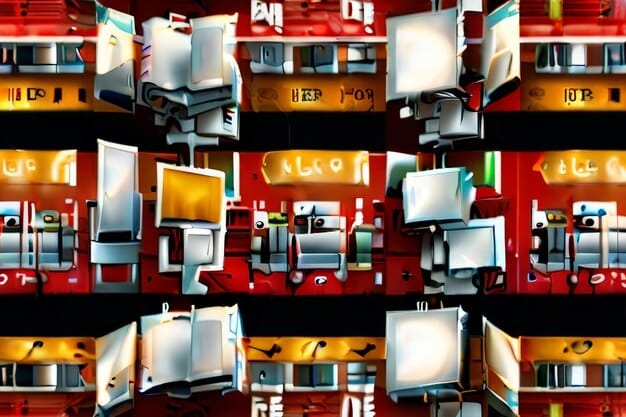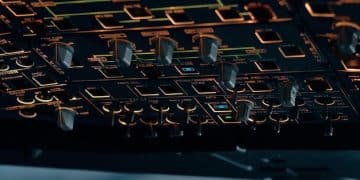Streamlining Your Short Film: A US Post-Production Workflow

Short film post-production workflow in the US involves crucial steps like editing, sound design, visual effects, and color correction, all aimed at refining raw footage into a polished cinematic experience that resonates with audiences.
Embarking on a short film project is an exciting endeavor, but the magic truly happens in post-production. A well-structured short film post-production workflow in the US is the key to transforming raw footage into a compelling and polished cinematic piece. Let’s dive into how to streamline your editing and visual effects process.
Understanding the Post-Production Landscape in US Short Films
Post-production is where your short film truly takes shape. Understanding the key stages and how they fit together is essential for a smooth and efficient process. This initial understanding can significantly impact the final product, ensuring your creative vision is fully realized.
In the US, the post-production landscape is rich with talent and resources, but navigating it requires knowledge of the specific steps involved. Here’s a breakdown to get you started.
Key Stages in Short Film Post-Production
The post-production process can be broken down into several key stages, each requiring specific skills and attention to detail:
- Editing: Assembling the footage into a coherent narrative. This includes selecting the best takes, cutting scenes, and creating the overall flow of the film.
- Sound Design: Enhancing the audio elements of the film, including dialogue editing, adding sound effects, and creating the musical score.
- Visual Effects (VFX): Adding computer-generated imagery or manipulating existing footage to create special effects.
- Color Correction and Grading: Adjusting the colors and tones of the film to create a consistent and visually appealing look.
These stages are often intertwined and iterative, requiring close collaboration between different specialists.
A clear understanding of these stages allows filmmakers to allocate resources effectively and maintain a consistent creative direction throughout the post-production process. By knowing what each stage entails, filmmakers can also anticipate potential challenges and plan accordingly, leading to a smoother and more efficient workflow.
Developing a Comprehensive Post-Production Plan
A detailed post-production plan is your roadmap to success. It outlines the tasks, timeline, and resources needed to complete your short film. Without a solid plan, you risk delays, budget overruns, and a final product that doesn’t meet your expectations.
Creating a well-defined plan ensures everyone on your team is on the same page and working towards a common goal.
Creating Realistic Timelines
One of the most critical aspects of post-production planning is creating a realistic timeline. This involves estimating the time required for each stage of the process and setting deadlines that are achievable. Underestimating the time needed can lead to rushing and compromising the quality of the final product.
Consider these factors when creating your timeline:
- Complexity of the Edit: A simple narrative will require less editing time than a complex, multi-layered story.
- Availability of Resources: Consider the availability of editors, sound designers, VFX artists, and colorists.
- Review and Approval Process: Factor in time for reviews and approvals from the director and producers.
By carefully considering these factors, you can create a timeline that is both ambitious and achievable, ensuring your short film is completed on time and to the highest standards.
Allocating time for revisions is also important. No project is perfect on the first pass, so planning for multiple iterations allows for refinement and improvement.
Optimizing Your Editing Workflow for Short Films
Editing is the backbone of your short film. A streamlined editing workflow is essential for crafting a compelling narrative. Effective organization, efficient software usage, and clear communication with the director are all key to a successful edit.
The editing process transforms raw footage into a cohesive story, setting the pace and tone of the film.

Implementing Efficient Editing Techniques
Efficiency in editing can save time and reduce frustration. Some techniques to consider include:
- Organizing Your Footage: Properly labeling and categorizing your footage makes it easier to find the right shots quickly.
- Using Keyboard Shortcuts: Mastering keyboard shortcuts in your editing software can significantly speed up your workflow.
- Creating Proxies: Working with lower-resolution proxies can improve performance and reduce strain on your computer.
These techniques can transform your editing process from a slow, tedious task into a streamlined and efficient workflow.
Experimenting with various editing software options is a good way to find the best fit for your project and personal style. Each software has its strengths and weaknesses, so research and testing are valuable.
Integrating Visual Effects to Elevate Your Film
Visual effects can add a layer of polish and creativity to your short film. Whether it’s subtle enhancements or complex CGI, effective VFX can elevate your film to new heights, captivating audiences with stunning visuals and seamless integration.
Integrating VFX requires planning and collaboration between the director, VFX supervisor, and VFX artists.
Collaborating with VFX Artists
Clear communication with your VFX artists is critical. This includes providing them with detailed briefs, reference materials, and feedback. The more clear you are about your vision, the better they can execute it. Establishing a good working relationship fosters innovation and ensures the VFX align with your overall aesthetic.
Consider these elements for collaboration:
- Detailed Briefs: Provide clear instructions and expectations for each VFX shot.
- Reference Materials: Share examples of the desired look and feel.
- Regular Feedback: Provide timely feedback throughout the VFX process.
By fostering a collaborative environment with your VFX artists, you can unlock their creativity and ensure the visual effects seamlessly integrate with your film, enhancing its impact and storytelling potential.
Early planning also allows for troubleshooting potential challenges and finding creative solutions before they impact the timeline. Regular communication ensures everyone is on the same page, leading to a more cohesive final product.
Mastering Sound Design and Audio Post-Production
Sound is just as important as visuals. High-quality sound design and audio post-production can significantly enhance the emotional impact of your short film. A well-crafted soundtrack can immerse the audience, heighten tension, and bring your story to life, adding layers of depth and nuance.
Effective sound design involves dialogue editing, sound effects, and music composition.
Effective Techniques for Audio Post-Production
Achieving professional-quality audio requires attention to detail and a mastery of various techniques:
- Dialogue Editing: Cleaning up dialogue and removing unwanted noise.
- Sound Effects: Adding realistic and creative sound effects to enhance the action and environment.
- Music Composition: Creating a musical score that complements the mood and tone of the film.
These techniques work together to create a cohesive and immersive audio experience for the audience.
Investing in quality audio equipment and software can significantly improve the audio quality. While budget constraints are always a factor, prioritizing audio can make a big difference in the final product. The right tools can help you achieve a professional sound, even on a limited budget.

Color Correction and Grading for a Polished Look
Color correction and grading are essential for achieving a consistent and visually appealing look for your short film. These processes involve adjusting the colors and tones of the footage to create a cohesive aesthetic and enhance the emotional impact of the film. A polished and consistent color grade can elevate your film’s production value, making it look more professional and visually engaging.
This step ensures the film has a consistent look and feel across all scenes.
Achieving the Desired Aesthetic
Color grading is more than just adjusting colors; it’s about creating a specific mood and tone. Experiment with different color palettes to achieve the desired aesthetic for your film. The color grade can enhance the emotional impact of the story, guiding the audience’s feelings and perceptions.
Some factors to consider include:
- Color Consistency: Ensure consistency across all scenes.
- Mood and Tone: Use color to enhance the emotional impact of the film.
- Skin Tones: Pay attention to accurate and pleasing skin tones.
By carefully considering these factors, you can create a color grade that not only looks visually appealing but also enhances the storytelling and emotional impact of your film.
Seeking feedback from peers and professionals is valuable in refining your color grade and achieving the desired aesthetic. Constructive criticism can help you identify areas for improvement and ensure your film has a polished and professional look.
| Key Point | Brief Description |
|---|---|
| 🎬 Editing Workflow | Optimize your footage organization and editing software shortcuts. |
| ✨ Visual Effects | Integrate VFX seamlessly and collaborate effectively with artists. |
| 🎵 Sound Design | Master dialogue editing, sound effects, and music composition. |
| 🎨 Color Grading | Achieve a consistent and visually appealing color palette. |
FAQ
▼
The initial step is often organizing and backing up all the raw footage, creating proxy files for smoother editing, and setting up project files in your chosen editing software.
▼
Sound design is crucial. It enhances the atmosphere, emphasizes emotions, and ensures clear dialogue, significantly impacting the audience’s experience and understanding of the story.
▼
Color grading involves adjusting the colors and tones of your footage to create a cohesive and visually appealing look. It’s necessary for achieving consistency and setting the film’s overall mood.
▼
Visual effects can add realism, create fantastical elements, and enhance storytelling. They range from subtle enhancements to complex CGI, making the unbelievable believable and engaging viewers.
▼
Popular editing software includes Adobe Premiere Pro, Final Cut Pro, and DaVinci Resolve. These tools offer robust features for editing, color correction, and audio mixing.
Conclusion
By mastering the process of short film post-production workflow in the US, you can transform raw footage into a polished and captivating cinematic experience. Streamlining your editing, integrating visual effects, mastering sound design, and perfecting color grading will ensure your film resonates with audiences and achieves its full potential.





